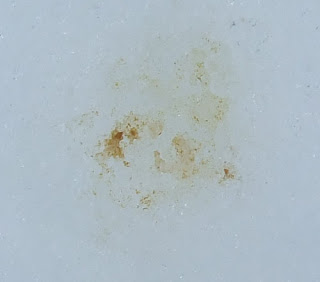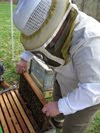 If you're curious like me you've probably wondered how honey gets from the bees to your kitchen and then to your waiting spoon.
If you're curious like me you've probably wondered how honey gets from the bees to your kitchen and then to your waiting spoon.Beekeepers keep their bees inside hollow boxes. The boxes have wooden frames that look like window panes (see the photo at left where I'm holding a frame). Instead of glass the frame is filled with honey combs built by the bees.
The bees will store their food (pollen and honey) inside the combs. Once the summer flowers bloom there is lots of nectar available for the bees to collect. They'll quickly fill all their frames with the nectar and they'll need more room.
 The beekeeper keeps a close eye on the bees and will add another hollow box with frames so they have more room to store their food.
The beekeeper keeps a close eye on the bees and will add another hollow box with frames so they have more room to store their food.This photo at left shows a typical beehive. The white box is the bees' home where the babies are. The pink and purple boxes are filled with just honey.
Honey bees are well known for being obsessive about collecting nectar. They never know when to stop. A honey bee will not look at all their honeycombs full of honey and say, "We don't need any more." As long as flowers are offering nectar, the field bees will bring it home, collecting much more than they can eat.
This is a great blessing to us. Can you guess why? Yes, it means there will be extra honey for you and me.
Because the bees collect so much, the beekeeper will need to keep giving them more hollow boxes of frames to keep up with how much they're collecting.
Once fall comes and the flowers are finished blooming, the beekeeper can collect his share of the honey. The beekeeper only takes the extra honey from the bees that they won't need, leaving the rest of the honey for the bees to eat all winter long while they're on vacation inside their hive.
In a summer with good weather, one hive can make as much as 100 pounds of extra honey. That's the honey you and I get to eat.
So, get your spoon out and get ready to taste that honey! Yum.




 Her Royal Highness, the Queen.
Her Royal Highness, the Queen. 



















